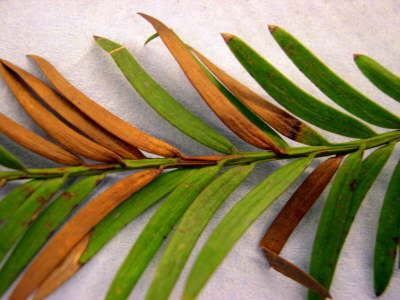They've Got Connections...
Though the coast
redwood is not affected severely by any sort of diseases, recent
studies show the pathogen
Phytophthora ramorum, or
Sudden Oak Death, is now known to have
an effect on
Sequoia sempervirens, along with more than three dozen other plant
species in California. Luckily though, there is still no evidence that mature
redwoods are harmed by the pathogen.
Phytophthora ramorum
is a parasitic water mold that has a wide range of hosts among
native California plants. Even if redwood seedlings and sprouts
are affected, the possibility that mature redwoods could show
resistance to infection still remains. Even if further research
specifies that redwoods are not significantly affected by Sudden
Oak Death, the disease still creates a major threat to the
ecosystem of the coast redwood. The most vulnerable species, tanoak, is a very common tree in the southern range of the redwood
forest that several animals depend on for food and shelter. The
death of these trees could potentially put the forest at risk
through loss of food and habitat, and thus could raise the total
amount of combustible material in the area, resulting in more
severe fires that could kill larger redwoods and Douglas firs.

As mentioned in the
earlier section,
Adaptations, redwoods have no insects that cause serious
damage. However, several insects are found living on the
redwood. These include a flatheaded twig borer and girdler, two
redwood bark beetles, and the
sequoia pitch moth.
When growing with other species of trees, redwoods are usually
the dominant tree. Although this is true, it is generally mixed
with other conifers and broad-leaf trees. Douglas fir can occupy
dominant and co-dominant positions along with the redwood,
competing with them for height. Common species of trees on the
coastal side of the redwoods include grand fir, western hemlock,
and Sitka spruce. The Sitka spruce outcompete the redwoods in
these areas because they are able to endure salty conditions.
These trees assist the redwoods by shielding them from salt and
wind. Other conifers found mixed with the redwoods include Gowen
cypress and various species of pine.
The two most common
hardwoods in the redwood areas are
tanoak and
Pacific madrone.
The tanoak grows far beneath the towering redwoods, where its
seedlings can tolerate shade better than redwoods. In addition,
their acorns establish themselves on the forest floor more
efficiently than the seeds of most trees. Other hardwoods found
with redwood are vine maple, bigleaf maple, red alder, giant
chinkapin, Oregon ash, Pacific bayberry, Oregon white oak,
cascara buckthorn, willows, and California-laurel. The most
common species of lesser vegetation found in association with
the coast redwood are bracken, sword fern, azalea, California
huckleberry, Pacific rhododendron, salmonberry, coyote-brush,
and snowbrush. The redwoods provide protection and shelter for
these plants and various others.

The redwoods offer shelter to many animals as well such as
birds like the spotted owl and the marbled murrelet, both of which
nest almost exclusively in old-growth redwood and Douglas fir
forests. Two species of threatened bird species that depend greatly
on the bay near the coast
redwoods for food include the
peregrine falcon and the
bald eagle.
Red tree voles, relatives of mice, live almost in the very tops of
the redwood trees, eating the needles.
Deer ticks that carry
Lyme
disease also occur in the coast redwood forests. Other animals found
among the coast redwoods include
mammals like black bears, elk, deer,
cougars, raccoons, squirrels,
and martens. Unfortunately, the black bear has been known to cause
serious damage to parts of the redwood region by stripping the bark
of the trees. Wide sections of bark are torn from the tree mainly
during the months of April to August. Younger, thinner trees are
damaged the most by this occurrence. Click
here to read more about this issue between the black bear
and the coast redwoods.


(A) (B)
In figure (A),
I captured a photo of the rare teddy bear species while I was out
walking through the Prairie Creek State Park. There are not many
sightings of this vicious creature, so I was very lucky to have
caught the wild beast on camera. However, the more common species
one would normally find in the Redwood State Parks is
Ursus americanus,
generally known as the black bear (B).
 The
banana slug is
also a very common organism found among coast
redwoods. Banana slugs chew leaves, waste from other animals, and
dead plant material, which it later recycles into soil. In addition
to working well as decomposers, they also benefit the forest by
spreading seeds and spores of different plants through their waste.
These slugs eat everything but redwood seedlings and seeds.
The
banana slug is
also a very common organism found among coast
redwoods. Banana slugs chew leaves, waste from other animals, and
dead plant material, which it later recycles into soil. In addition
to working well as decomposers, they also benefit the forest by
spreading seeds and spores of different plants through their waste.
These slugs eat everything but redwood seedlings and seeds.
Redwood
If you would like to know more about any of the following organisms that are connected to the coast redwood, just click on the website!
Cougar: http://bioweb.uwlax.edu/bio203/s2008/cory_amy/
Peregrine falcon: http://bioweb.uwlax.edu/bio203/s2008/lauterba_jona/
Bald eagle: http://bioweb.uwlax.edu/bio203/s2007/taylor_andr/
Sweet violet: http://bioweb.uwlax.edu/bio203/s2008/tacke_kati/
Deer Tick: http://bioweb.uwlax.edu/bio203/s2008/clarin_bria/
Lyme Disease bacteria: http://bioweb.uwlax.edu/bio203/s2007/joyce_kait/
Even more organisms can be found by going to:
Click on Human Impacts to learn how humans have affected coast redwoods throughout history.
Go back to Reproduction.
Home Sweet
Home